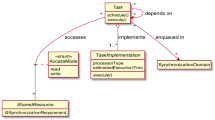Abstract
The El'brus-3 and MARS-M represent two recent efforts to address the Soviet Union's high-performance computing needs through original, indigenous development. The El'brus-3 extends very long instruction word (VLIW) concepts to a multiprocessor environment and offers features that increase performance and efficiency and decrease code size for both scientific and general-purpose applications. It incorporates procedure static and globally dynamic instruction scheduling, multiple, simultaneous branch path execution, and iteration frames for executing loops with recurrences and conditional branches. The MARS-M integrates VLIW, data flow, decoupled heterogeneous processors, and hierarchical systems into a unified framework. It also offers a combination of static and dynamic VLIW scheduling. While the viability of these machines has been demonstrated, significant barriers to their production and use remain.
Similar content being viewed by others
References
Babayan, B. A. 1989. Basic results and prospects for development of the “El'brus” architecture. Prikladnaya Informatika, 15: 100–113.
Babayan, B.A., Ryabov, G.G., and Chinin, G.D. 1989. El'brus software methodology: Instrumentation-experience. In Information Processing 89, Proc., 11th World Computer Congress (San Francisco, Aug. 28–Sept. 1), North-Holland, Amsterdam, pp. 879–882.
Colwell, R.P., O'Donnell, J.J., Papworth, R.D., and Rodman, P.K. 1987. A VLIW architecture for a Trace scheduling compiler. In Proc., Second Internat. Conf. on Architectural Support for Programming Languages and Operating Systems (ASPLOS-II) (Palo Alto, Calif., Oct. 5–8), pp. 180–192.
Dorozhevets, M.N. 1988. The use of virtual processes in hardware and microprogrammed implementation of an operating system kernel. Ph.D. thesis, Computing Center of the Siberian Dept. of the USSR Academy of Sciences, Novosibirsk.
Farrens, M.K., and Pleszkun, A.R. 1991. Implementation of the PIPE processor. IEEE Comp., (Jan.): 65–70.
Marchuk, G.I., and Kotov, V. Ye. 1978. Modular, asynchronous, expandable system (conception), parts 1 and 2. Computing Center of the Siberian Dept. of the USSR Academy of Sciences, Novosibirsk.
Rau, B.R., Glaeser, C.D., and Greenwalt, E.M. 1982. Architectural support for the effective generation of code for horizontal architectures. In Proc., Symp. on Architectural Support for Programming Languages and Operating Systems (Palo Alto, Calif., Mar. 1–3), pp. 96–99.
Rau, B.R., Yen, D.W.L., Yen, W., and Towle, R.A. 1989. The Cydra 5 departmental supercomputer. IEEE Comp., 22, 1 (Jan.): 12–35.
Smith, J.E. 1989. Dynamic instruction scheduling and the Astronautics ZS-1. IEEE Comp. (July): 21–35.
Smith, J.E., Weiss, S., and Pang, N.Y. 1986. A simulation study of decoupled architecture computers. IEEE Trans. Comps., C-35, 8 (Aug.): 692–702.
Wolcott, P., and Goodman, S.E. 1988. High-speed computers of the Soviet Union. IEEE Comp. (Sept.): 32–41.
Wolcott, P., and Goodman, S.E. 1990. Soviet high-speed computers: The new generation. In Proc., Supercomputing '90 (New York, Nov. 12–16), IEEE Comp. Soc. Press, pp. 930–939.
Wolfe, A., and Shen, J.P. 1991. A variable instruction stream extension to the VLIW architecture. In ASPLOS-IV Proc.: Fourth Internat. Conf. on Architectural Support for Programming Languages and Operating Systems (Santa Clara, Calif., Apr. 8–11), pp. 2–14.
Vishnevskiy, Yu.L. 1982. Architectural features of the Mini-MARS processor. Computing Center of the Siberian Dept. of the USSR Academy of Sciences, Novosibirsk, 5–33.
Author information
Authors and Affiliations
Additional information
This paper was written nearly entirely by means of e-mail between Tucson and Novosibirsk. It is one of the first examples of this type of collaboration between Russian and American colleagues.
Rights and permissions
About this article
Cite this article
Dorozhevets, M.N., Wolcott, P. The El'brus-3 and MARS-M: Recent advances in Russian high-performance computing. J Supercomput 6, 5–48 (1992). https://doi.org/10.1007/BF00128641
Issue Date:
DOI: https://doi.org/10.1007/BF00128641




